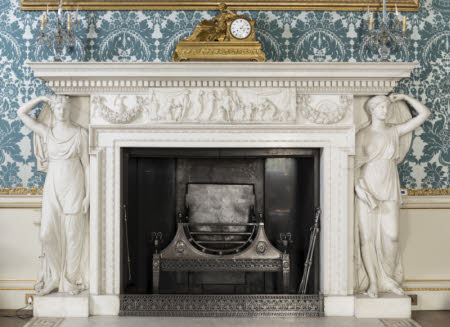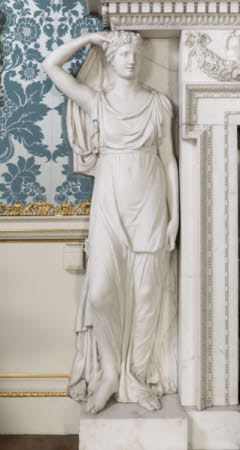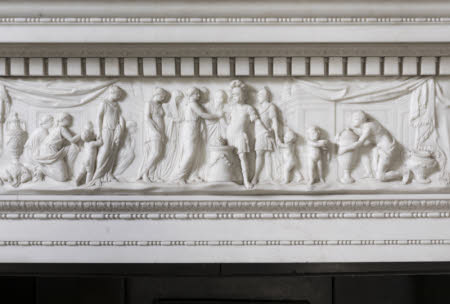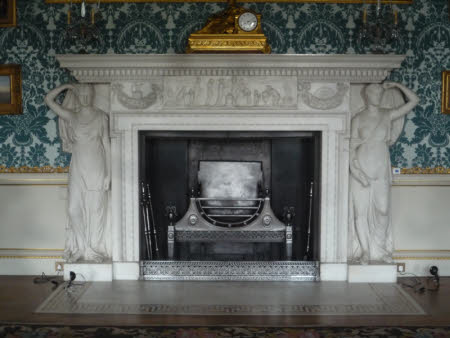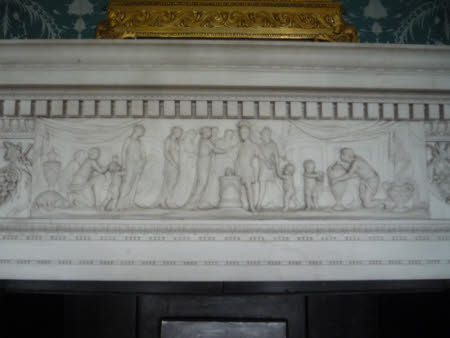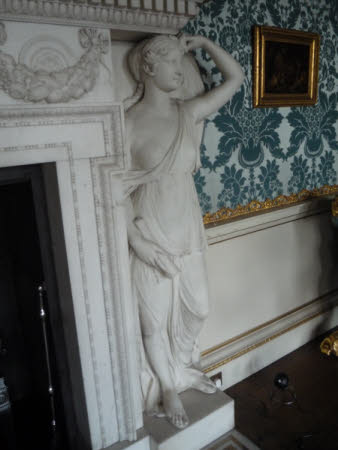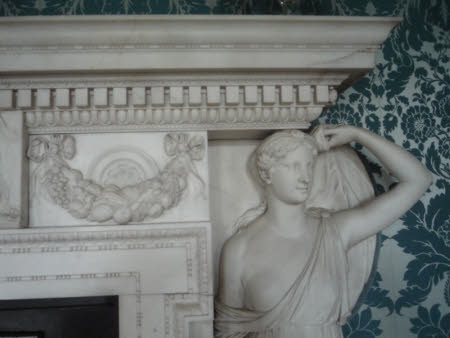The Drawing Room fireplace
Robert Adam (Kirkcaldy 1728 - London 1792)
Category
Architecture / Features & Decoration
Date
circa 1760 - 1763
Materials
Marble and alabaster
Measurements
1945 x 3290 x 360 mm
Place of origin
Great Britain
Order this imageCollection
Kedleston Hall, Derbyshire
NT 107932.1
Summary
White marble, the Drawing Room chimneypiece, attributed to Michael Henry Spang (d. 1762) after Robert Adam (1728-92). c. 1760-63. A chimneypiece attributed to Michael Henry Spang, designed by Robert Adam. In white marble with rectangular shelf, cornice moulded with palmette, dentil, egg and dart, and bead motifs. The breakfront has a centralized rectangular relief panel depicting Virtue rewarded by riches and honour. Virtue ('virtus') is figured as a male soldier, standing within a great temple, next to an altar. A woman in classical robes (possibly an allegorical figure or goddess) stands on the opposite side of the altar and points towards Virtue. A congregation of men and women, including another soldier stand behind them. At left and right children and attendants bring forth gifts in great vases and urns to honour Virtue. The scene is framed by fringed drapes pulled back to reveal the ceremony. To the left and right of the panel are relief festoons of flowers, fruit and foliage suspended by ribbons. Behind the left festoon is a jug in relief decorated with a cameo portrait and handle in the shape of a leopard. Behind the right festoon a circular dish in relief with rosette at centre. Recessed to the left and right of the breakfront are two caryatid female figures in classical drapery, each holding their mantles to their heads with their proper right and proper left hands respectively, mirroring each other. The figure at left has curly hair tied in a chignon and wears a full peplos. The figure at right holds a scroll in the proper right hand and wears a headdress; her peplos has fallen off the proper right shoulder to expose her breast. The Drawing Room was completed in 1763 to designs by Robert Adam (see NT 109434). Robert Adam's original design for the chimneypiece is in Sir John Soane's Museum (SM Adam volume 22/15).
Full description
The sculptor Michael Henry Spang was a native of Denmark and was first recorded in England in 1758 after modeling a seal for the Royal Society of Arts. A receipt in the Kedleston Archive from James 'Athenian' Stuart (1713-88) marked 'London August 9 1758' shows that Spang was subcontracted by Stuart to carve four figures in wood (NT 108997) for the sum of £28 (around £2,800 in today's money). Spang was later commissioned to produce the Dining Room, Drawing Room and Music Room chimneypieces for Kedleston, for which he was paid £990 (see NT 107982, 107920). There are three designs by Spang for a ceiling, a bridge and a pavilion for Kedleston (NT 109248, 109249, 109499), a drawing of a mournful Sigismunda (NT 108920), and a miniature wax seal of the Scarsale coat of arms (NT 109110). Spang also acquired for Curzon a model of a British warship (NT 109114). Alice Rylance-Watson 2019
Provenance
Purchased by Nathaniel Curzon (1726-1804) c. 1760-63 as part of Robert Adam's remodelling of Kedleston; identifiable in 'Catalogue of the pictures, statues, &c. at Kedleston' (1769) as 'Chimney-piece, Statuary Marble. Two whole-length Female Figures. Tablet, Virtue rewarded with Riches and Honour, basso-relievo' (p. 12); purchased with part of the contents of Kedleston with the aid of the National Heritage Memorial Fund in 1987 when the house and park were given to the National Trust by Francis Curzon, 3rd Viscount Scarsdale (1924-2000).
Credit line
Kedleston Hall, The Scarsdale Collection (acquired with the help of the National Heritage Memorial Fund and transferred to The National Trust in 1987)
Makers and roles
Robert Adam (Kirkcaldy 1728 - London 1792), architect attributed to Michael Henry Spang (fl.c.1750 - d.London 1762), sculptor Robert Adam (Kirkcaldy 1728 - London 1792), designer
References
Harris 1987: Leslie Harris and Gervase Jackson-Stops (ed.), Robert Adam and Kedleston: The Making of a Neo-Classical Masterpiece, London 1987
